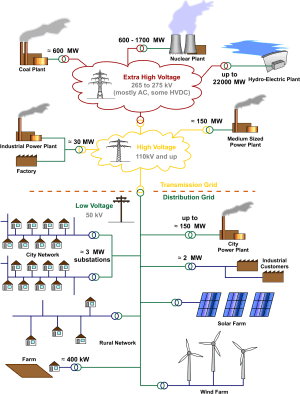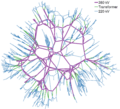Electrical grid facts for kids
An electrical grid is like a giant, invisible highway system for electricity! It's a huge network that connects everything needed to get power from where it's made to your home, school, or any place that uses electricity. Think of it as a big team effort involving power plants, long transmission lines, local distribution lines, and finally, all the places that use the power. The grid makes sure that electricity flows smoothly from where it's created by generators at a power station to all the customers who need it.
Contents
What is an Electrical Grid?
An electrical grid is a complex system that delivers electricity to millions of people. It includes four main parts:
- Power generation: Where electricity is made, usually at power plants.
- Power transmission: Long lines that carry electricity over long distances.
- Power distribution: Shorter lines that bring electricity to your neighborhood.
- Power load: All the places that use electricity, like homes, schools, and factories.
All these parts work together to make sure you have power when you need it.
How Electricity is Made
Electricity starts its journey at a power plant. These plants use different types of energy to spin large machines called generators. For example, some plants burn coal or natural gas, while others use the power of moving water (hydroelectric) or wind. Nuclear power plants also create electricity. No matter the source, the goal is to make those generators spin and produce electricity.
Sending Power Far Away
Once electricity is made, it needs to travel to cities and towns. This is where power transmission comes in. Very high-voltage lines, often seen as tall towers with many wires, carry electricity over long distances. These lines are like the major highways of the electrical grid. They move huge amounts of power efficiently from the power plants to substations closer to where people live.
Getting Power to Your Neighborhood
When electricity reaches a substation, its voltage is lowered. From there, power distribution lines take over. These are the smaller power lines you see on poles in your neighborhood or buried underground. They branch out, like local streets, to deliver electricity directly to homes, schools, and businesses. Before it enters your building, the electricity goes through a final transformer, which lowers the voltage to a safe level for your appliances.
Why the Grid is Important
The electrical grid is super important for our daily lives. It makes sure that electricity is available whenever we flip a switch. Without the grid, we wouldn't have lights, computers, refrigerators, or many other things we use every day. It allows power to be shared across wide areas, so if one power plant has a problem, others can often pick up the slack.
Keeping the Grid Working
Keeping the electrical grid running smoothly is a big job. Engineers and technicians constantly monitor the grid to make sure electricity flows correctly. Sometimes, things can go wrong, like during a big storm or if equipment breaks down. This can cause a blackout, where the power goes out. When this happens, teams work quickly to fix the problem and get the power back on. They also work on making the grid smarter and more reliable for the future.
Images for kids
-
500 kV Three-phase electric power Transmission Lines at Grand Coulee Dam; four circuits are shown; two additional circuits are obscured by trees on the right; the entire 7079 MW generation capacity of the dam is accommodated by these six circuits.
-
A brownout near Tokyo Tower in Tokyo, Japan
-
Toronto during the Northeast blackout of 2003, which required black-starting of generating stations.
See also
 In Spanish: Red eléctrica para niños
In Spanish: Red eléctrica para niños











